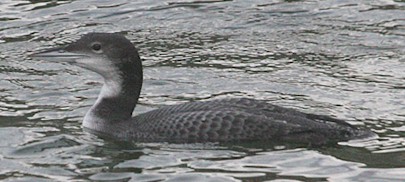Staines Reservoir
From Londonbirders
| Line 1: | Line 1: | ||
| - | + | '''Location''' | |
| + | |||
| + | Map: [http://www.streetmap.co.uk/newmap.srf?x=505500&y=173500&z=3&sv=505500,173500&st=4&ar=N&mapp=newmap.srf&searchp=newsearch.srf] | ||
| + | |||
| + | The two reservoirs (North and South Basins) are just north of Staines town and lie to the southwest of Heathrow Airport. Most people will drive here and parking is available on the west side of the reservoirs on the busy A3034. For public transport users, the quickest way is to use the mainline rail station at Staines which is a 15 minute walk away. Local buses serve the area, especially to Ashford Hospital on the east side. | ||
| + | |||
| + | '''Access''' | ||
| + | |||
| + | Open access via the causeway which bisects the two basins. There is strictly no access to any other part of the reservoirs nor the adjacent King George VI Reservoir. The causeway is a good meeting place for birders to find out what's around in West London. It's also renowned for being windy or, in summer, plagued with clouds of insects. | ||
| + | |||
| + | [[Image:Avm gndiver.jpg]] | ||
| + | |||
| + | Great Northern Diver at Staines Res, 26.11.06 (photo by Andrew Moon). The large expanse of waters is particularly attractive to divers and 1-2 are seen at Staines most years. | ||
| + | |||
| + | '''Birds''' | ||
| + | |||
| + | One of the best sites in London for rarities, Staines has attracted an impressive list of species over the years including waders such as Baird's Sandpiper, Collared Pratincole, Buff-breasted, Sharp-tailed and Pectoral Sandpipers, Long-billed Dowitcher, two Wilson's Phalaropes and three Lesser Yellowlegs. However, seeing any wader here usually requires one of the basins to be drained, which seems to happen every few years. Migrant waders can be found on the water's edge when both basins are full but there is usually very little variety. | ||
| + | |||
| + | Gulls and Terns also offer the chance of at least a scarce bird for London such as Little Gull or Black and Arctic Tern, all of which are regularly recorded on passage. Rarities here have included Whiskered, White-winged Black, Caspian and even Sooty Tern although considerable doubt has been cast over that particular record. | ||
| + | |||
| + | Seabirds can be found here when there has been a storm, such as Leach's Petrel, Sabine's Gull and four species of skua. Skuas are sometimes also seen on passage. | ||
| + | |||
| + | The large expanse of water (424 acres) attract other birds, especially migrant raptors such as Osprey, Marsh, Hen and even Montagu's Harriers. Other rarities include Alpine Swift, Roller, Bee-eater, Hoopoe, Wryneck and Icterine Warbler. | ||
| + | |||
| + | The causeway often attracts passage migrants such as Black Redstart, Rock and Water Pipits and Wheatears. | ||
Current revision as of 10:30, 15 August 2007
Location
Map: [1]
The two reservoirs (North and South Basins) are just north of Staines town and lie to the southwest of Heathrow Airport. Most people will drive here and parking is available on the west side of the reservoirs on the busy A3034. For public transport users, the quickest way is to use the mainline rail station at Staines which is a 15 minute walk away. Local buses serve the area, especially to Ashford Hospital on the east side.
Access
Open access via the causeway which bisects the two basins. There is strictly no access to any other part of the reservoirs nor the adjacent King George VI Reservoir. The causeway is a good meeting place for birders to find out what's around in West London. It's also renowned for being windy or, in summer, plagued with clouds of insects.
Great Northern Diver at Staines Res, 26.11.06 (photo by Andrew Moon). The large expanse of waters is particularly attractive to divers and 1-2 are seen at Staines most years.
Birds
One of the best sites in London for rarities, Staines has attracted an impressive list of species over the years including waders such as Baird's Sandpiper, Collared Pratincole, Buff-breasted, Sharp-tailed and Pectoral Sandpipers, Long-billed Dowitcher, two Wilson's Phalaropes and three Lesser Yellowlegs. However, seeing any wader here usually requires one of the basins to be drained, which seems to happen every few years. Migrant waders can be found on the water's edge when both basins are full but there is usually very little variety.
Gulls and Terns also offer the chance of at least a scarce bird for London such as Little Gull or Black and Arctic Tern, all of which are regularly recorded on passage. Rarities here have included Whiskered, White-winged Black, Caspian and even Sooty Tern although considerable doubt has been cast over that particular record.
Seabirds can be found here when there has been a storm, such as Leach's Petrel, Sabine's Gull and four species of skua. Skuas are sometimes also seen on passage.
The large expanse of water (424 acres) attract other birds, especially migrant raptors such as Osprey, Marsh, Hen and even Montagu's Harriers. Other rarities include Alpine Swift, Roller, Bee-eater, Hoopoe, Wryneck and Icterine Warbler.
The causeway often attracts passage migrants such as Black Redstart, Rock and Water Pipits and Wheatears.

